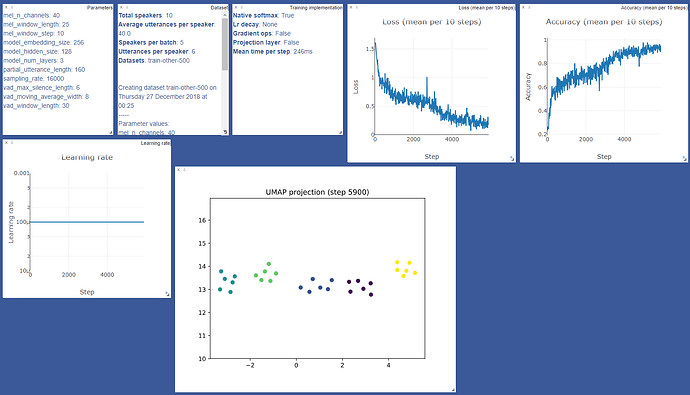I would like to draw the loss convergence for training and validation in a simple graph. So far I found out that PyTorch doesn’t offer any in-built function for that yet (at least none that speaks to me as a beginner). I think it might be the best to just use some matplotlib code. I couldn’t figure out how exactly to do it though. I would be happy if somebody could give me hints how to incorporate the necessary code into my training & validation code:
def train_model(learning_rate, l2_penalty, epochs):
print(str(datetime.datetime.now()).split('.')[0], "Starting training and validation...\n")
print("====================Data and Hyperparameter Overview====================\n")
print("Number of training examples: %d, Number of validation examples: %d" %(len(training_dataframe), len(validation_dataframe)))
print("Learning rate: %.5f, Embedding Dimension: %d, Hidden Size: %d, Dropout: %.2f, L2:%.10f\n" %(learning_rate, emb_dim, encoder.hidden_size, encoder.p_dropout, l2_penalty))
print("================================Results...==============================\n")
optimizer = torch.optim.Adam(dual_encoder.parameters(), lr = learning_rate, weight_decay = l2_penalty)#*
loss_func = torch.nn.BCEWithLogitsLoss()
loss_func.cuda()
best_validation_accuracy = 0.0
for epoch in range(epochs):
shuffle_dataframe(training_dataframe)
sum_loss_training = 0.0
training_correct_count = 0
dual_encoder.train()
for index, row in training_dataframe.iterrows():
context_ids, response_ids, label = load_ids_and_labels(row, word_to_id)
context = autograd.Variable(torch.LongTensor(context_ids).view(-1,1), requires_grad = False).cuda()
response = autograd.Variable(torch.LongTensor(response_ids).view(-1, 1), requires_grad = False).cuda()
label = autograd.Variable(torch.FloatTensor(torch.from_numpy(np.array(label).reshape(1,1))), requires_grad = False).cuda()
score = dual_encoder(context, response)
loss = loss_func(score, label)
sum_loss_training += loss.data[0]
loss.backward()
optimizer.step()
optimizer.zero_grad()
training_correct_count = increase_count(training_correct_count, score, label)
training_accuracy = get_accuracy(training_correct_count, training_dataframe)
shuffle_dataframe(validation_dataframe)
validation_correct_count = 0
sum_loss_validation = 0.0
dual_encoder.eval()
for index, row in validation_dataframe.iterrows():
context_ids, response_ids, label = load_ids_and_labels(row, word_to_id)
context = autograd.Variable(torch.LongTensor(context_ids).view(-1,1)).cuda()
response = autograd.Variable(torch.LongTensor(response_ids).view(-1, 1)).cuda()
label = autograd.Variable(torch.FloatTensor(torch.from_numpy(np.array(label).reshape(1,1)))).cuda()
score = dual_encoder(context, response)
loss = loss_func(score, label)
sum_loss_validation += loss.data[0]
validation_correct_count = increase_count(validation_correct_count, score, label)
validation_accuracy = get_accuracy(validation_correct_count, validation_dataframe)
print(str(datetime.datetime.now()).split('.')[0],
"Epoch: %d/%d" %(epoch,epochs),
"TrainLoss: %.3f" %(sum_loss_training/len(training_dataframe)),
"TrainAccuracy: %.3f" %(training_accuracy),
"ValLoss: %.3f" %(sum_loss_validation/len(validation_dataframe)),
"ValAccuracy: %.3f" %(validation_accuracy))
if validation_accuracy > best_validation_accuracy:
best_validation_accuracy = validation_accuracy
torch.save(dual_encoder.state_dict(), '/output/saved_model_%d_examples.pt' %(len(training_dataframe)))
print("New best found and saved.")
print(str(datetime.datetime.now()).split('.')[0], "Training and validation epochs finished.")

